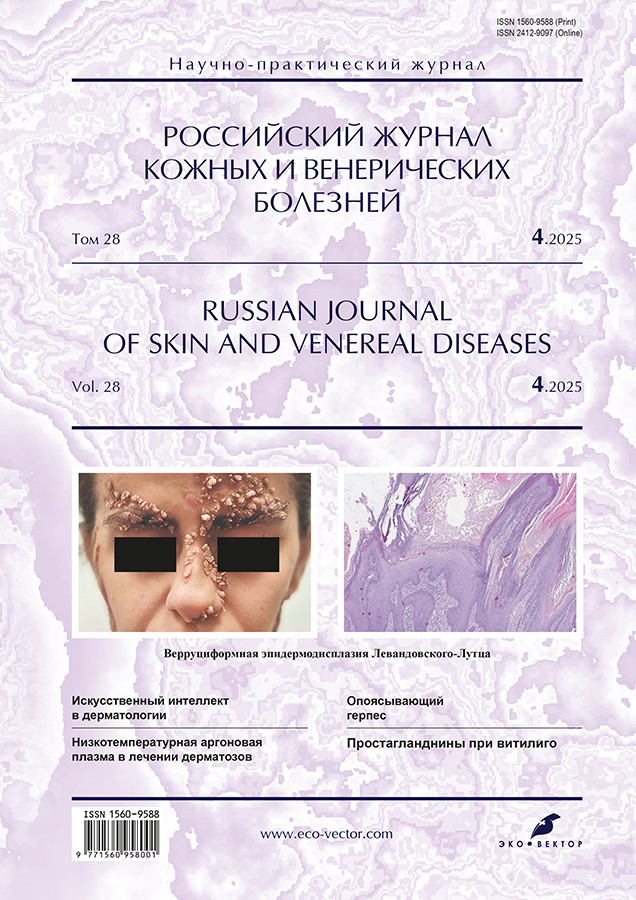Dermatoscopic methods for diagnosing radiation-induced skin reactions in patients with primary cutaneous lymphomas undergoing total skin electron beam therapy
- Authors: Zelianina M.I.1, Vinogradova J.N.1, Kozlova D.V.1,2, Zaslavsky D.V.2, Ilyin N.V.1, Gilvanova E.V.1
-
Affiliations:
- Granov Russian Research Center of Radiology and Surgical Technologies
- Saint-Petersburg State Pediatric Medical University
- Issue: Vol 28, No 4 (2025)
- Pages: 381-390
- Section: DERMATO-ONCOLOGY
- URL: https://bakhtiniada.ru/1560-9588/article/view/350467
- DOI: https://doi.org/10.17816/dv678173
- EDN: https://elibrary.ru/BUVGIU
- ID: 350467
Cite item
Abstract
Background: Timely diagnosis and assessment of radiation-induced skin reactions remain an important challenge in modern medicine. Imaging techniques can help standardize the clinical evaluation of radiation dermatitis.
Aim: The work aimed to evaluate dermatoscopic features and confocal microscopy findings in radiation dermatitis among patients with primary cutaneous lymphomas undergoing radiotherapy, with subsequent analysis of the clinical and morphological characteristics of affected skin areas before treatment and at cumulative doses of 6 Gy, 14 Gy, and 30 Gy, based on macroscopic and dermatoscopic imaging of radiation-induced skin reactions for further comparison.
Methods: Data from 40 patients at the Granov Russian Scientific Center for Radiology and Surgical Technologies receiving electron beam radiotherapy for primary cutaneous lymphomas were analyzed. As clinical symptoms of radiation-induced skin reactions developed, morphological changes in the affected areas were examined. Dermatoscopic evaluation of skin lesions was performed using a HYPERLINK "https://shop.heine-med.ru/catalog/dermatoskopy/?ysclid=m63jpoace3558532091"Heine Optotechnik (Germany) dermatoscope at tenfold magnification. Confocal spectroscopy was conducted using the VivaScope® 1500 medical device (MAVIG GmbH, Munich, Germany). Instrumental data underwent correlation analysis to identify statistical relationships between dermatoscopic parameters and the severity of radiation-induced skin reactions.
Results: Dermatoscopy revealed patterns characteristic of different stages of radiation-induced skin reactions: reticular vascular arrangements in the dermis, brown scaly elements, perifollicular pigmentation, and follicular plugs arranged in rosette-like patterns. Confocal microscopy of radiation dermatitis lesions identified non-stochastic skin changes, including exocytosis (55.3%), spongiosis (63.5%), disorganization of the epidermis (65%), and abnormally structured dermal papillae (85.4%). Low-contrast microvascular cells marking vascular dysfunction in the dermal vascular bed were a specific feature of radiation dermatitis observed regardless of severity.
Conclusion: Accurate assessment of skin damage severity can help optimize the management of patients undergoing radiotherapy for primary cutaneous lymphomas. These findings are promising for integrating instrumental evaluation methods into routine clinical practice for early detection of radiation-induced skin changes and predicting disease severity.
Full Text
##article.viewOnOriginalSite##About the authors
Maria I. Zelianina
Granov Russian Research Center of Radiology and Surgical Technologies
Author for correspondence.
Email: m.zelianina@rambler.ru
ORCID iD: 0000-0002-0172-9763
SPIN-code: 3201-9685
Russian Federation, 70 Leningradskaya st, Saint Petersburg, 197758
Julia N. Vinogradova
Granov Russian Research Center of Radiology and Surgical Technologies
Email: winogradova68@mail.ru
ORCID iD: 0000-0002-0938-5213
SPIN-code: 8876-8936
MD, Dr. Sci. (Medicine), Assistant Professor
Russian Federation, 70 Leningradskaya st, Saint Petersburg, 197758Darya V. Kozlova
Granov Russian Research Center of Radiology and Surgical Technologies; Saint-Petersburg State Pediatric Medical University
Email: dashauchenaya@yandex.ru
ORCID iD: 0000-0002-6942-2880
SPIN-code: 3783-8565
Russian Federation, 70 Leningradskaya st, Saint Petersburg, 197758; Saint Petersburg
Denis V. Zaslavsky
Saint-Petersburg State Pediatric Medical University
Email: venerology@gmail.com
ORCID iD: 0000-0001-5936-6232
SPIN-code: 5832-9510
MD, Dr. Sci. (Medicine), Professor
Russian Federation, Saint PetersburgNikolay V. Ilyin
Granov Russian Research Center of Radiology and Surgical Technologies
Email: ilyin_prof@mail.ru
ORCID iD: 0000-0002-8422-0689
SPIN-code: 2242-2112
MD, Dr. Sci. (Medicine), Professor
Russian Federation, 70 Leningradskaya st, Saint Petersburg, 197758Elina V. Gilvanova
Granov Russian Research Center of Radiology and Surgical Technologies
Email: masiuka1@yandex.ru
ORCID iD: 0000-0003-2476-6169
Russian Federation, 70 Leningradskaya st, Saint Petersburg, 197758
References
- Errichetti E, Zalaudek I, Kittler H, et al. Standardization of dermoscopic terminology and basic dermoscopic parameters to evaluate in general dermatology (non-neoplastic dermatoses): an expert consensus on behalf of the International Dermoscopy Society. Br J Dermatol. 2020;182(2):454–467. doi: 10.1111/bjd.18125
- Zelianina MI, Vinogradova YuN, Zaslavskiy DV, et al. Increasing the effectiveness of total-skin electron beam therapy by reducing the manifestations of radiation dermatitis in patients with primary lymphomas. A comparative randomized prospective study. J Modern Oncol. 2024;26(3):317–322. doi: 10.26442/18151434.2024.3.202898 EDN: UIHTQX
- Pilśniak A, Szlauer-Stefańska A, Tukiendorf A, et al. Dermoscopy of chronic radiation-induced dermatitis in patients with head and neck cancers treated with radiotherapy. Life. 2024;14(3):399. doi: 10.3390/life14030399
- Ilyin NV, Vinogradova YuN, Zelianina MI, et al. Radiation induced skin reactions in primary cutaneous lymphoma patients: a review. J Modern Oncol. 2023;25(2):185–189. EDN: ZBRCUC
- Zelianina MI, Vinogradova YuN. The effect of electron radiation on the microvascular bed of normal skin tissues in patients with skin lymphomas. Problems in oncology. 2023;69(3S):436–437. (In Russ.) EDN: YFMYDX
- Yashayaeva A, Dahn H, Svatos M, et al. A prospective study demonstrating early prediction of skin toxicity from radiation therapy using radiomic features from optical and infrared images. Int J Radiat Oncol Biol Phys. 2024:118(3):839–852. doi: 10.1016/j.ijrobp.2023.09.043
- Cox JD, Stetz J, Pajak TF. Toxicity criteria of the radiation therapy oncology group (RTOG) and the European organization for research and treatment of cancer (EORTC). Int J Radiat Oncol Biol Phys. 1995;31(5):1341–1346.
- Pilśniak A, Szlauer-Stefańska A, Tukiendorf A, et al. Dermoscopy of acute radiation-induced dermatitis in patients with head and neck cancers treated with radiotherapy. Sci Rep. 2023;13(1):15711. doi: 10.1038/s41598-023-42507-1 EDN: NADYFE
- Lange-Asschenfeldt S, Babilli J, Beyer M, et al. Consistency and distribution of reflectance confocal microscopy features for diagnosis of cutaneous T cell lymphoma. J Biomed Opt. 2012;17(1):016001. doi: 10.1117/1.JBO.17.1.016001
- Pietkiewicz P, Navarrete-Dechent C, Togawa Ya, et al. Applications of ultraviolet and sub-ultraviolet dermatoscopy in neoplastic and non-neoplastic dermatoses: a systematic review. Dermatol Ther (Heidelb). 2024;14(2):361–390. doi: 10.1007/s13555-024-01104-4
- Sekiguchi K, Akahane K, Ogita M, et al. Efficacy of heparinoid moisturizer as a prophylactic agent for radiation dermatitis following radiotherapy after breast-conserving surgery: a randomized controlled trial. Jpn J Clin Oncol. 2018;48(5):450–457. doi: 10.1093/jjco/hyy045
- Balaeva DA, Garyaev GA, Ter-Ovanesov M.D, et al. Study of the use of la roche-posay dermatological laboratory skincare products for radiodermatitis prevention and treatment. Supportive Therapy in Oncology. 2024;1(2):14–22. doi: 10.17650/3034-2473-2024-1-2-14-22 EDN: UOXYJK
Supplementary files









